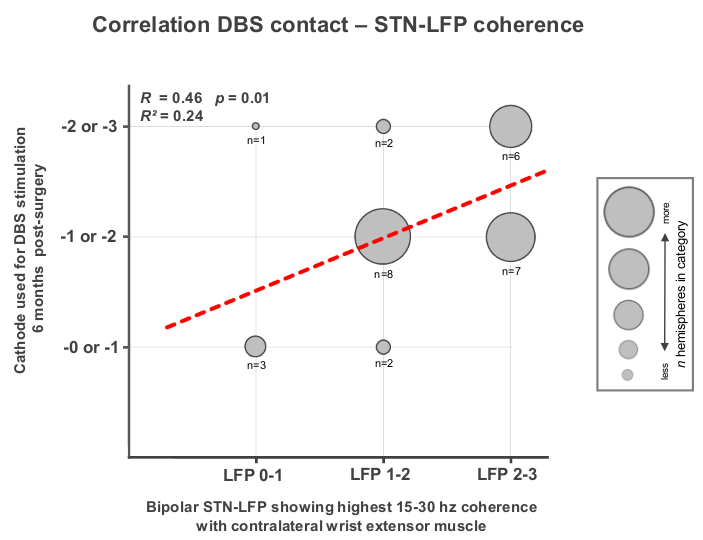Session Information
Date: Monday, June 5, 2017
Session Title: Surgical Therapy: Parkinson’s Disease
Session Time: 1:45pm-3:15pm
Location: Exhibit Hall C
Objective: To investigate whether subthalamic nucleus (STN)-EMG coherence can be used to predict the most effective deep brain stimulation (DBS) contact.
Background: Although DBS is an established therapy for Parkinson’s Disease (PD), there are still limitations in terms of efficacy, tolerability and efficiency. For instance, the optimal titration of stimulation parameters is still performed manually and requires lengthy clinical programming sessions. In order to proceed to automated DBS programming, a symptom-specific biomarker is necessary. In the current study we evaluated STN-EMG beta (15-30 Hz) coherence as a potential biomarker for automated DBS contact selection and aimed to reproduce the finding of Marsden et al. (Brain, 2001) in a larger cohort.
Methods: Fifteen PD patients (59±7 yo, 9 male, disease duration: 10±2 yr) indicated for bilateral STN-DBS surgery were included. Direct after DBS lead placement, STN local field potentials (LFP) and contralateral wrist extensor muscle EMG were recorded during a 2 minute gripping isometric force task (10% of maximum contraction). Segments with continuous muscle activity were selected for calculating three bipolar STN-EMG coherence profiles (respectively DBS contacts “0-1”, “1-2”, and “2-3”). The DBS contact that was used for stimulation 6 months post-surgery was identified as the clinical most effective contact. The cathode stimulation contact was correlated (two-sided Spearman’s rank) to the bipolar contacts with the highest median beta STN-EMG coherence.
Results: In total 29 STNs were recorded. One hemisphere was excluded since the DBS lead was repositioned after initial surgery. In 17 of 29 (59%) hemispheres, the bipolar LFP with the highest median beta coherence included the (cathode) DBS contact that gave the best clinical response. In line with this, a significant correlation between best coherence contact pair and DBS stimulation site was present (R=0.46, p=0.01) (Fig. 1).[figure1]
Conclusions: Our data suggest that STN-EMG coherence profiles might assist in selecting the most effective DBS contact in PD and potentially could be used in future automated DBS programming algorithms. However, our correlation was less strong compared to the study of Marsden et al. (Brain, 2001). This might be due to the fact that some patients had not yet achieved the optimal stimulation parameters after 6 months and that we only assessed isometric and not dynamic contraction.
References: Marsden JF, Limousin-Dowsey P, Ashby P, Pollak P, Brown P. Subthalamic nucleus, sensorimotor cortex and muscle interrelationships in Parkinson’s disease. Brain 2001;Feb;124:378-88.
To cite this abstract in AMA style:
J. van Zijl, J. Elting, T. van Laar, F. Lange, G. Drost, D. Oterdoom, J. van Dijk, M. Tijssen, M. Beudel. Automated DBS Contact Selection using Coherence in Parkinson’s Disease [abstract]. Mov Disord. 2017; 32 (suppl 2). https://www.mdsabstracts.org/abstract/automated-dbs-contact-selection-using-coherence-in-parkinsons-disease/. Accessed December 29, 2025.« Back to 2017 International Congress
MDS Abstracts - https://www.mdsabstracts.org/abstract/automated-dbs-contact-selection-using-coherence-in-parkinsons-disease/

